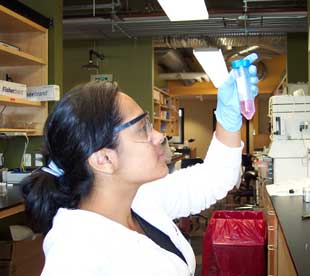|
Peptone Curve Lab
THE PROCEDURE:
In this lab the students tested how Halobacterium would act when it was introduced to Peptone. Peptone is a type of food that was scientifically made by the scientist. |
The hypothesis made by the interns was that Halobacterium would grow best at high concentrations of peptone because there were higher levels of peptone introduced. |
There was five concentrations of peptone: 0%,1%, 2%, 3%, and 5%. Halobacterium was introduced to the peptone and it was incubated for 48 hours at 37 degrees Celsius at 220 rpm. Following incubation the interns measured the cell density of Halobacterium in the peptone by using the spectrophotometer. |
 |
The results were quite intriguing; it was found that Halobacterium grew best at 1% peptone, rather than 5% peptone. The interns wanted to know why Halobacterium grew best at the lowest concentration of peptone. They asked the scientist and it was explained that peptone may contain a toxic substance. Therefore at higher levels of peptone there is higher levels of a toxic substance, which could be killing Halobacterium, whereas at a lower level of peptone may not contain a lot of this toxic substance; hence Halobacterium could grow much better. |
THE REFLECTION:
What was interesting in doing this lab was the ¿why? Sure if you look at our graph the more peptone the more life, but this is only true up to a certain point. I wouldn’t die if I had a more abundant amount of nutritive food than before. We found that the answer didn’t lie in our talking about food, but peptone. Peptone is essentially proteins broken down into stings of amino acids called peptides. The process in breaking down these proteins includes using detergents. Traces of these detergents in the peptone at small amounts wouldn’t affect Halobacterium, but large amounts will cause the cells to lyce.
Click here to get lab Protocol
|
